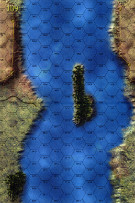|
|
|
Total |
| Side 1 |
1 |
| Draw |
0 |
| Side 2 |
1 |
|
Total |
| Side 1 |
1 |
| Draw |
0 |
| Side 2 |
1 |
|
Total |
| Side 1 |
0 |
| Draw |
0 |
| Side 2 |
0 |
|
| Overall Rating, 2 votes |
|---|
|
|
|
Scenario Rank:
--- of 964 |
| Parent Game |
River Battleships |
| Historicity |
Historical |
| Date |
1939-09-17 |
| Start Time |
07:00 |
| Turn Count |
20 |
| Visibility |
Day |
| Counters |
20 |
| Net Morale |
0 |
| Net Initiative |
0 |
| Maps |
2: 108, 109 |
| Layout Dimensions |
86 x 28 cm
34 x 11 in |
| Play Bounty |
157 |
| AAR Bounty |
223 |
| Total Plays |
2 |
| Total AARs |
0 |
|
Introduction
|
|
The Polish Pinsk Flotilla struggled to get into the fight against the invading Soviets, hampered by the abnormally low water levels in the Pinsk River. Had the river flowed deeply enough to allow easy transit, they still would face the monitors and gunboats of the Soviet Pinsk Flotilla which had been formed precisely to oppose them.
|
|
Conclusion
|
|
The Polish flotilla tried to get into action to fight the Soviets. But low water on the Pinsk and its tributaries kept snagging the monitors as they advanced, and eventually the crews ended up scuttling their vessels and setting out on foot to fight the invaders. The Soviets would raise five of the six monitors and two gunboats for their own Pinsk flotilla. Most of the officers and many of the crewmen of the Riverine Flotilla were murdered in the Katyn Forest in 1940.
|
Display Relevant AFV Rules
| AFV Rules Pertaining to this Scenario's Order of Battle |
- Vulnerable to results on the Assault Combat Chart (7.25, 7.63, ACC), and may be attacked by Anti-Tank fire (11.2, DFT). Anti-Tank fire only affects the individual unit fired upon (7.62, 11.0).
- AFV's are activated by tank leaders (3.2, 3.3, 5.42, 6.8).
They may also be activated as part of an initial activating stack, but if activated in this way would need a tank
leader in order to carry out combat movement.
- AFV's do not block Direct Fire (10.1).
- Full-strength AFV's with "armor efficiency" may make two anti-tank (AT) fire attacks per turn
(either in their action segment or during opportunity fire) if they have AT fire values of 0 or more
(11.2).
- Each unit with an AT fire value of 2 or more may fire at targets at a distance of between 100% and 150% of its
printed AT range. It does so at half its AT fire value. (11.3)
- Efficient and non-efficient AFV's may conduct two opportunity fires per turn if using direct fire
(7.44, 7.64).
Units with both Direct and AT Fire values may use either type of fire in the same turn as their opportunity fire,
but not both (7.22, 13.0).
Units which can take opportunity fire twice per turn do not have to target the same unit both times (13.0).
- Demoralized AFV's are not required to flee from units that do not have AT fire values (14.3).
- Place a Wreck marker when an AFV is eliminated in a bridge or town hex (16.3).
- AFV's do not benefit from Entrenchments (16.42).
- AFV's may Dig In (16.2).
- River Vessels: see Rule 15.2 ~ 15.22
|
Soviet Union Order of Battle


 RiBa012
RiBa012 











